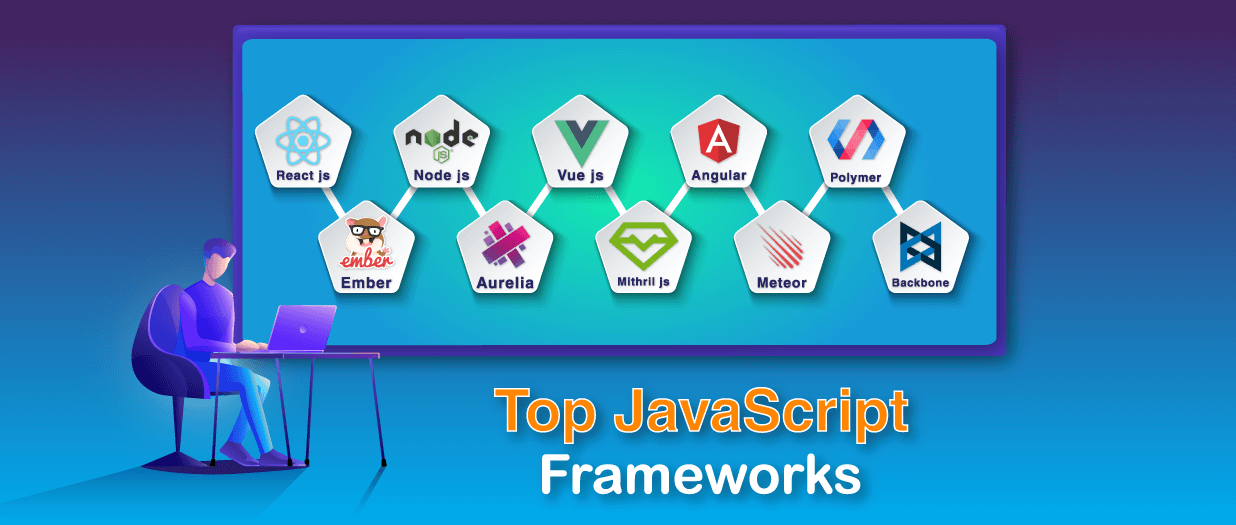Frontend JavaScript frameworks have become essential tools for web developers to streamline the process of building dynamic and interactive web applications. Here are some key benefits and notes about popular frontend JavaScript frameworks.
1.React:
Developed by Facebook, React is one of the most popular libraries for building user interfaces. It's often used in combination with other libraries and tools to create single-page applications (SPAs).
React allows developers to build UIs using reusable components, which simplifies code organization and maintenance.
A vast community and ecosystem of libraries and tools make React a popular choice for frontend development.
React Applications
Facebook:While not entirely built with React, various parts of Facebook, including its News Feed and Ads Manager, use React components.
Instagram:Instagram's web application uses React for its frontend.
WhatsApp:WhatsApp's web client utilizes React for its user interface.
Vue.js
Vue.js is known for its simplicity and ease of integration into existing projects. It gained popularity for its flexible and approachable nature. Vue allows developers to encapsulate templates, styles, and JavaScript logic in a single file, enhancing component modularity. Vue's reactivity system makes it easy to track changes in data and automatically update the UI, simplifying state management.
Vue Applications
Alibaba: Alibaba Group's e-commerce platforms, including Alibaba, Taobao, and Alipay, have adopted Vue.js in different parts of their applications.
Xiaomi: Xiaomi's official website and some of its web applications use Vue.js for frontend development.
Angular
Developed by Google, Angular is a comprehensive framework that provides a full set of tools for building complex web applications. It's suitable for large-scale projects. Angular offers a comprehensive set of tools for building complex web applications, including dependency injection and powerful templating. Angular provides two-way data binding, reducing the need for manual DOM manipulation and making apps more responsive. Angular is written in TypeScript, which brings static typing and improved code maintainability.
Angular Applications
Google: Google uses Angular in various products and applications, such as Google Ads and Google Cloud Platform's Console.
Alibaba: Some parts of Microsoft's Azure Portal are built using Angular.
Node.js
Although not a traditional framework, Node.js is a runtime environment that allows you to run JavaScript on the server side. It's widely used for building server-side applications and APIs.
Node Js Applications
Netflix: Netflix employs Node.js for its server-side applications, contributing to its ability to handle large-scale streaming services.
PayPal: PayPal uses Node.js for some of its backend services to improve performance and developer productivity
Express.js
Express.js is a minimal and flexible Node.js web application framework designed for building the server-side of web applications. It simplifies tasks like routing, middleware, and handling HTTP requests and responses. Express.js is known for its middleware architecture, which allows developers to add functionality to the request/response processing pipeline. This is useful for tasks such as authentication, logging, and error handling. Express provides a simple and intuitive way to define routes and handle various HTTP methods like GET, POST, PUT, DELETE, etc. This makes it easy to create RESTful APIs and web applications.
Express Js Applications
Uber: Uber uses Express.js to build some of its backend services, particularly in the UberEATS platform.
MySpace: Parts of MySpace's platform were built using Express.js.
Ember.js
It follows the convention over configuration (CoC) and the don't-repeat-yourself (DRY) principles, which means it provides a set of conventions and best practices to streamline web development. While it might not be as widely mentioned as some other frameworks
Ember Js Applications
Discourse: Discourse is an open-source, modern discussion platform for communities and forums. It's known for its clean and responsive design and is built using Ember.js for the frontend.
Ghost Admin: Ghost is a popular open-source CMS for creating blogs and publications. The Ghost Admin interface, which allows content creators to manage their publications, is built using Ember.js.
LinkedIn Mobile: LinkedIn has used Ember.js for its mobile web application. While the main LinkedIn website uses a different technology stack, the mobile version utilizes Ember.js for its user interface.
Conclusion
Certainly, here's a short conclusion that applies to JavaScript frameworks in general: JavaScript frameworks, whether on the frontend (e.g., React, Angular, Vue.js) or backend (e.g., Express.js), play a pivotal role in modern web development. They streamline development, enhance performance, and provide a structured approach to building web applications. The choice of a framework depends on project requirements, developer expertise, and the desired features and characteristics of the application. Each framework has its own strengths, making it essential to evaluate them based on specific project needs for optimal results.
